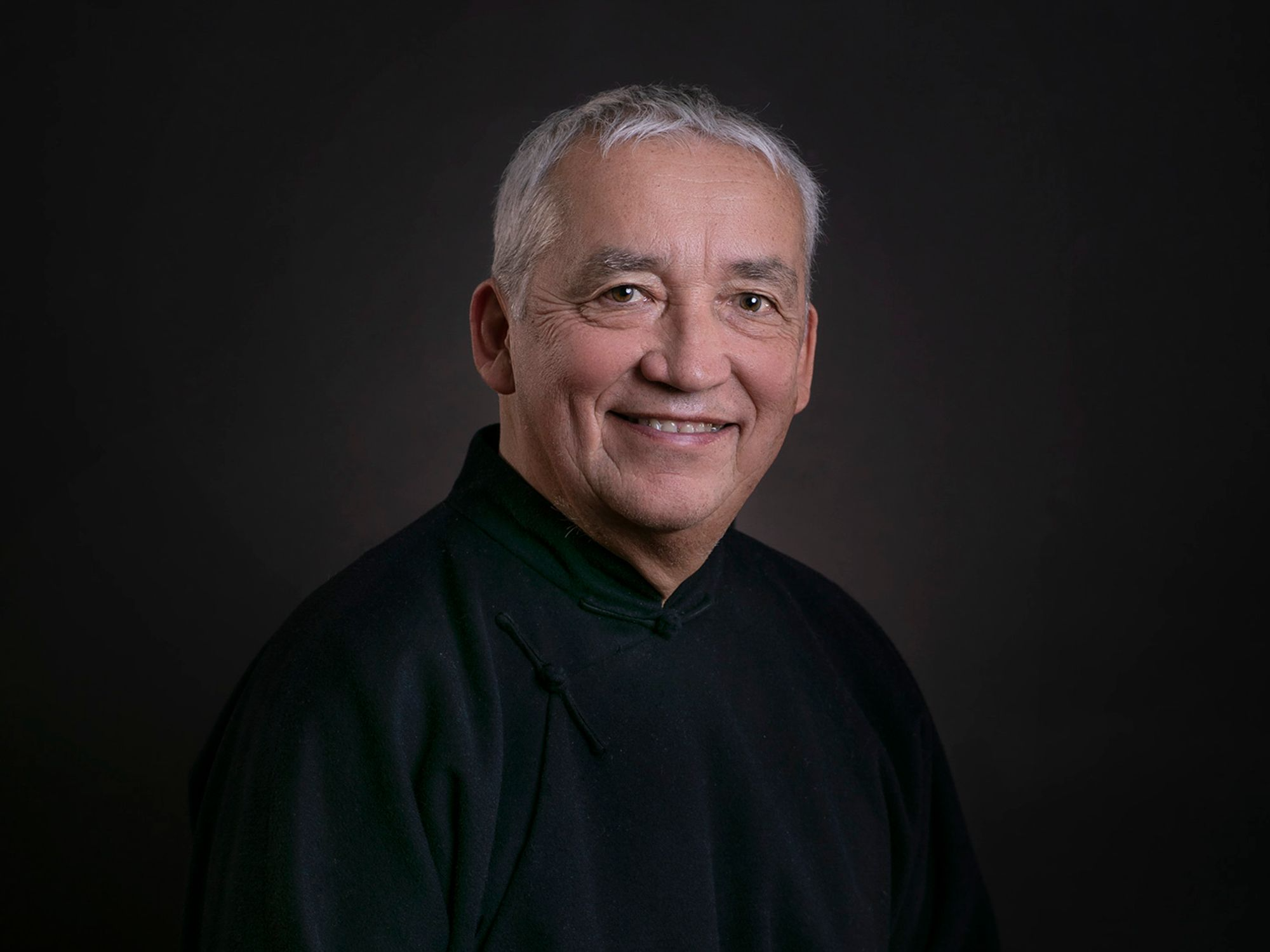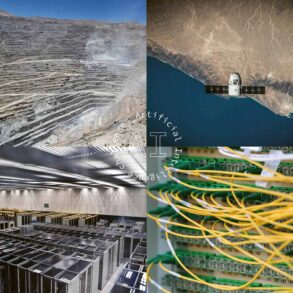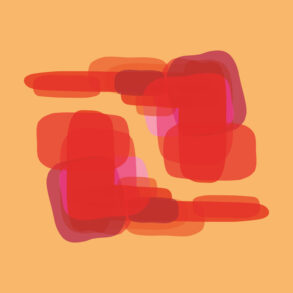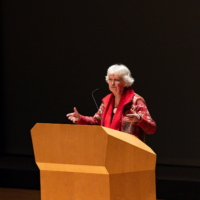Can we find a path, as farmers and as human beings, that helps alleviate the suffering in the world? At this year’s Agriculture Conference, Ha Vinh Tho spoke about three fundamental tasks of the mission of agriculture for the future that address this question. Here are excerpts from that talk.
[Ha Vinh Tho began his talk with a short mindfulness exercise for the entire audience, which he concluded as follows:] Here we are as human beings, between heaven and earth. With each in-breath, each out-breath, each heartbeat, we are connecting heaven and earth in our hearts. As each one of us does this for himself or herself, we are also doing it collectively. Not only with the 900 or 1,000 people who are here and those online, but with all the people who make it possible for us to be here. This community of thousands is actually a representative of a vast community and, in the end, of the community of humankind, because each one of us and all of us collectively have this task as human beings: to connect heaven and earth in our own heart.
We are celebrating 100 years of biodynamic agriculture, and just recently, we had the 100-year anniversary of the foundation of the Anthroposophical Society and the revealing of the Foundation Stone Meditation, which holds, like in a nutshell or a seed, the expression of the threefoldness of the human being in its connection with the threefoldness of the whole cosmos, which I believe is the very foundation of agriculture.
The Root Cause of Suffering
In these past days, farmers were protesting all over Europe. I thought it is very significant that we are trying to rethink agriculture at a moment when farmers are suffering tremendously and trying to voice their suffering. I was really moved and so disappointed by the kind of answers that they were given. “Okay, we’ll give you a little bit more money.” “Okay, we’ll take a few regulations away.” “Okay, we’ll diminish the price of petrol for your machines.” As if that was the problem. The suffering that so many farmers are manifesting – not only in Europe, in many countries around the world – these are just symptoms. Have we made the effort to look at the root causes behind the symptoms? This really awakened in me the experience I’ve had in many different contexts. For instance, in education. They all start their profession with a strong ideal, and after a few years, many of them really are desperate, asking: “What am I doing here?” I’ve met many people in health care – doctors and nurses. It’s the same thing. They start with so much compassion and a will to heal. And then the system breaks that. Same with farmers.
What is this system? One powerful aspect of it is that these profoundly human aspirations to transform, to heal, to feed, to teach, are reduced to merely economic activities – the only purpose is to make more profit at any cost, at any human cost, and at any ecological cost. I used to work for the International Committee of the Red Cross in war zones, where we try to alleviate the suffering of people who are in the worst possible situations. Sometimes, I felt we were trying to get people out of the river that they had fallen into. It is the right thing to do if you can. But I asked myself, isn’t it possible to go upstream and create conditions so that people don’t fall in the river in the first place? That’s when I transitioned from humanitarian work to trying to contribute to changing the development paradigm from one focused on profit and economic growth to one focused on the common good, happiness for all people, and well-being for all life forms.
I believe the root cause in farming – and it’s very similar in education or healthcare and other fields – is that the actual mission is lost. We have to restore what Ueli Hurter called “the dignity of farming.” This has to do with feeling the deeper mission of agriculture. I believe that this deeper mission is a threefold one.
Transforming the Earth
First of all, obviously, agriculture has the mission to feed the world. Feeding happens at different levels – physical food is one. Agriculture is about mobilizing the will, so that this will can transform the earth. I’m not saying anything new. The sister from Egypt said it’s the love that we give to the earth that comes back to us as healthy food. Very powerful, very beautiful. The sister from South Africa spoke about the indigenous wisdom that knows this deep connection between human and Earth and all living beings. So we don’t have to reinvent it, but we have to bring it in in such a way that it fits the needs of our time. Agriculture is not just nature as it was, not just the given. The task of humankind is to transform the Earth, to make it something more noble, more spiritual, more transparent, so that the spirit can penetrate the Earth.
In the Foundation Stone Meditation, Steiner gives three exercises. For the first, he says: practice remembering the spirit in the depth of the soul. What is the depth of the soul? It’s the will, right? When we work with our limbs, when we plough the earth, we are doing something very material; we’re working with the physical dimension. Can we remember the spirit when we are working in the depths of the earth, so that our action is actually a transformation process?
When a child is born, it receives a physical body given by heredity, from its ancestors. How does the child transform this body to make it a vessel for its own spirit, for its unique individuality? The whole of child development is this process of gradually taking hold of and transforming this body, so that it can become, as much as possible, a vessel for the unique individuality of this specific child. That’s what each of us does individually. Collectively, as humankind, we do that for the Earth. That’s a major part of what agriculture is about: transforming the body of the Earth so that it can become a vessel for the spirit. And that’s the first, extremely noble, profound mission of agriculture: transformation.
Healing in Community
When we look at the mythologies and spiritual traditions of the world, we see that in all cultures, we have an imagination of a god or godlike figure that gave agriculture to humankind. We didn’t invent agriculture; the foundations were given to us by divine or semi-divine beings. And interestingly enough, in almost all traditions, the god or the being that brings agriculture is also connected with healing. For instance, in the Chinese-Vietnamese tradition, the divine farmer at the origin of agriculture is also the one who gave traditional medicine. Why? Because it’s the knowledge of plants and how plants work, how they can heal.
Agriculture gives meaning to time. For you, as a farmer, time is not just a clock: it’s the seasons, the cycle of nature. Time becomes rhythm, and rhythm is healing. Time without rhythm is destructive, but when time becomes rhythm, rhythm gives meaning to time and is a healing power.
For the second exercise that Steiner suggests, there are many translations – I like my own: practice mindfulness of the spirit in the equanimity of the soul. The first exercise is remembering the spirit when we are in the depths of the will. The second one is practicing balance. It’s a transformation of our natural emotions into something that is balanced and in harmony with the rhythm of the cosmos. This allows us to be mindful of the present, of the spirit in the soul. And what is the impact of that? It is community building. Farms are communities. Our friend from Canada shared how her farm produces vegetables; yes, but more than that, it produces community building.
Rudolf Steiner says something really interesting: “Let from the East inflame what through the West takes form.” I brought something for you. [Holds up two little bags.] This bag is full of Vietnamese organic rice and this bag is full of Demeter wheat. East and West, rice and wheat. The question is not whether one is better or superior – these are the two fundamental food staples, the two main sources of nutrition for humankind. If we can see that rice and wheat are brothers, if we can see how what the West brings to the world and what the East brings to the world complement each other – the fire of the East enthusing the forming capacity of the West – it would be a significant contribution to world peace. We’ve been living in dualities. Those who are different are enemies, or inferior, or whatever. But rice and wheat are not competing. These are the two big cultures of the world: the rice culture and the wheat culture. Moon-related, sun-related. And we need both: we need the sun and the moon.
It was amazing when the sister from Egypt spoke about the economy of love. This is about bringing into the economy – which, for the time being, is mostly a destructive force in our world – the heart power of love that transforms it into something that is healing for humankind. The time has come when we have to become aware that we are one 8-billion-strong family, one family. That we become aware of our interdependence. We inter-are. The sister from South Africa spoke about Ubuntu – “I am because you are.” But “you” is the 8 billion of us.
This healing force of the heart lives in rhythm. It lives in the balance of the soul that enables us to be mindful of the reality of the spirit, and it lives in the community-building force when these apparently polar forces can work together. So, the second fundamental mission of agriculture has to do with the soul, with the heart. The first one is transforming, the second one is healing, and healing is community-building. Agriculture is a healing art, a heart art.
Awakening in Spirit
Finally, how do we connect directly with the spirit? In the foundation stone meditation, Rudolf Steiner says: practice contemplating, seeing, perceiving the spirit in the stillness of the thoughts. When the inner noise quiets down, and an inner stillness arises, we can directly perceive the spirit. That’s about awakening.
The third movement, then, is like a prayer, rising from the earth towards the sky. The first is a vertical movement from the sky, from the spirit, enlightening and transforming matter. The second is a horizontal movement where, in the balance of our transformed emotions, we can perceive, or contemplate, or be mindful of the spirit. And the third movement is awakening to our true being, to our authentic being.
If we see the mission of agriculture as part of the mission of humankind that has these three fundamental functions: to transform matter, to heal on the soul level, and to awaken at a spiritual level, then we really perceive the dignity of agriculture, which is the dignity of being human. And now the question is, how can you, in your specific vocation as a farmer, seize these three fundamental tasks so that they can really contribute to the development of humankind?
So, going back to the beginning, what is the source of suffering? The source of suffering is, first of all, in modern times or in our materialistic culture, we have lost the connection to our spiritual being, to our own true self. We don’t know who we are, and if we can’t connect to our true being, we cannot perceive the true being of others. That’s the second source of suffering: we are isolated and disconnected. We feel alone. And the third source of suffering is that we are disconnected from our planet, which is our mother. Without our planet Earth, there is no life possible for us. If agriculture can really experience deeply that these inner and outer processes are one, if as individuals we can connect to our true being, then we can truly connect to others, and then we can truly transform the Earth.
I would like to really acknowledge that we are not alone. We are carried by the generations and generations of our ancestors who did their best, and we have to continue that. And we are responsible for generations and generations of our children and grandchildren. I’m a great-grandfather, very proud of it, and I feel really concerned about the future. I want my children, my grandchildren, and my great-granddaughter and their children to have a good earth to live on. I think agriculture has a very important role to play in that. And there are our spiritual ancestors. Our sisters from Egypt mentioned that maybe Rudolf Steiner and Doctor Abouleish are together in heaven. I’m sure they are. And many others.
When I first came to Dornach in 1970, it was almost only German-speaking. French or Italian would be as exotic as we would get. Somebody like me being here was like, “Who’s that?” We have moved a lot forward. If we manage to really recognize that, if we can bring in this manifoldness of spiritual heritages that were already present here, we can develop a biodynamic movement that is really, truly, universally human – so that we can be carried both by the genetic ancestors for the well-being of the future generations, but also by the many invisible beings and spiritual traditions that are all waiting for us, so that we can, even if humbly, even if modestly, make the right contribution for the development, for the evolution of humankind towards transformation, healing, and awakening. Thank you very much.
The full lecture is available for free and on demand at Goetheanum.tv
More Eurasia Learning Institute
Image Ha Vinh Tho









